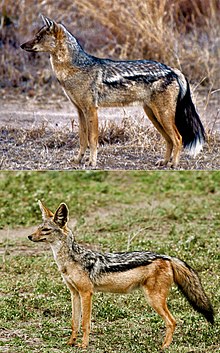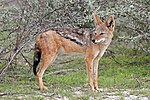Lupulella
| Lupulella Temporal range: Pliocene - recent
| |
|---|---|

| |
| Side-striped and black-backed jackals | |
| Scientific classification | |
| Domain: | Eukaryota |
| Kingdom: | Animalia |
| Phylum: | Chordata |
| Class: | Mammalia |
| Order: | Carnivora |
| Family: | Canidae |
| Subfamily: | Caninae |
| Tribe: | Canini |
| Subtribe: | Canina |
| Genus: | Lupulella Hilzheimer, 1906 |
| Extant species | |

| |
| Lupulella range Lupulella adusta Lupulella mesomelas | |
Lupulella is a genus[1][2][3] of canine found in Africa.[4] This genus consists of only two extant species, the black-backed jackal (Lupulella mesomelas) and the side-striped jackal (Lupulella adusta).[3][1][2]
Taxonomy
The two species had previously been considered members of the genus Canis. In 2017, a taxonomic review recommended that these two species be recognised as genus Lupulella.[5] In response to this review, the American Society of Mammalogists recognised the new genus.[3]
In 2019, a workshop hosted by the IUCN/SSC Canid Specialist Group recommends that because DNA evidence shows the side-striped jackal (Canis adustus) and black-backed jackal (Canis mesomelas) to form a monophyletic lineage that sits outside of the Canis/Cuon/Lycaon clade, that they should be placed in a distinct genus, Lupulella (Hilzheimer, 1906) with the names Lupulella adusta and Lupulella mesomelas.[1]
| Image | Name | Common name | Distribution |
|---|---|---|---|
 |
Lupulella adusta (Sundevall, 1847) | Side-striped jackal | 
central and southern Africa |
 |
Lupulella mesomelas (Schreber, 1775) | Black-backed jackal | 
eastern and southern Africa. |
Phylogeny
Cladogram based on genomic data:[6]
References
- ^ a b c Alvares, Francisco; Bogdanowicz, Wieslaw; Campbell, Liz A.D.; Godinho, Rachel; Hatlauf, Jennifer; Jhala, Yadvendradev V.; Kitchener, Andrew C.; Koepfli, Klaus-Peter; Krofel, Miha; Moehlman, Patricia D.; Senn, Helen; Sillero-Zubiri, Claudio; Viranta, Suvi; Werhahn, Geraldine (2019). "Old World Canis spp. with taxonomic ambiguity: Workshop conclusions and recommendations. CIBIO. Vairão, Portugal, 28th - 30th May 2019" (PDF). IUCN/SSC Canid Specialist Group. Retrieved 6 March 2020.
- ^ a b Castelló, José R. (2018). "Ch2-Wolf-like Canids". Canids of the World: Wolves, Wild Dogs, Foxes, Jackals, Coyotes, and Their Relatives (Princeton Field Guides). Princeton University Press. pp. 160–165. ISBN 978-0691176857.
- ^ a b c "Mammal Diversity Database". American Society of Mammalogists. Retrieved 28 December 2020.
- ^ Hoffmann, M. (2014). "Canis adustus". IUCN Red List of Threatened Species. 2014: e.T3753A46254734. doi:10.2305/IUCN.UK.2014-1.RLTS.T3753A46254734.en. Retrieved 12 November 2021.
- ^ Viranta, Suvi; Atickem, Anagaw; Werdelin, Lars; Stenseth, Nils Chr. (2017). "Rediscovering a forgotten canid species". BMC Zoology. 2. doi:10.1186/s40850-017-0015-0.
- ^ K. Lindblad-Toh, C. M. Wade, T. S. Mikkelsen, E. K. Karlsson, D. B. Jaffe, M. Kamal, M. Clamp, J. L. Chang, E. J. Kulbokas, M. C. Zody, E. Mauceli, X. Xie, M. Breen, R. K. Wayne, E. A. Ostrander, C. P. Ponting, F. Galibert, D. R. Smith, P. J. Dejong, E. Kirkness, P. Alvarez, T. Biagi, W. Brockman, J. Butler, C. W. Chin, A. Cook, J. Cuff, M. J. Daly, D. Decaprio e S. Gnerre, Genome sequence, comparative analysis and haplotype structure of the domestic dog, in Nature, vol. 438, nº 7069, 2005, pp. 803–819, Bibcode:2005Natur.438..803L, DOI:10.1038/nature04338, PMID 16341006.
External links
 Data related to Lupulella at Wikispecies
Data related to Lupulella at Wikispecies
